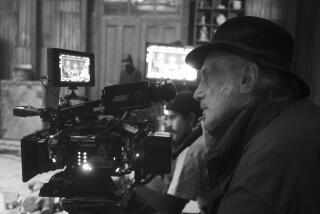Machaty Films in ‘Czech Modernism’ Series
Although Czechoslovakia, like the other Eastern European countries, has a long and rich history in the cinema, the only well-known pre-’60s Czech film is Gustav Machaty’s “Ecstasy” (1933), notorious for its nude scenes featuring 19-year-old Hedy Lamarr. Anyone who has actually seen “Ecstasy” knows that its once heavily censored sequences are stunning in their poetic eroticism. Machaty, who died in 1963 at 62, is the key discovery of the opening programs of the UCLA Film Archive’s comprehensive “Czech Modernism: 1900-1945,” which commences next Saturday with Machaty’s “Erotikon” (1929) and his “Kreutzer Sonata” (1926).
“The Kreutzer Sonata” and “Erotikon” are pictures of tremendous sophistication, in their worldliness and in their elegant settings, many of them featuring striking Art Deco motifs. In the first, a rich, sad, unhandsome middle-aged man (Jan W. Speerger) recalls in flashback the unraveling of his classically unhappy marriage to a pretty, bored woman (Eva Byronova), younger than he and the mother of their three young children.
When the couple, at the wife’s urging, move from their country estate to a luxurious city residence the wife becomes a social butterfly. She is smitten with a handsome concert violinist (Miroslav Paul) whom she enjoys accompanying on the piano, especially Beethoven’s “Kreutzer” Sonata, which the husband finds so ominous and mournful.
Even more striking is “Erotikon,” a remarkable collaboration between Machaty and cameraman Vaclav Vich, which features dramatically cropped images, many of them in close-up. In combination with his mastery of a dazzling sensuality and understanding of the psychology of sexual passion, this bold, economic style makes Machaty still seem ahead of his time.
In its plot, “Erotikon” is a simple melodrama; a suave, confident foreigner, meticulously tailored and probably meant to be English (Olaf Fjord), seduces a naive country girl (Ita Rina); when they cross paths a few years later, the girl, now a chic woman happily married to a devoted, well-off man, finds herself still dangerously attracted to the seducer who has brought her so much grief; Machaty is terrificly honest about the power of sex. As in “The Kreutzer Sonata” much of the action of “Erotikon” takes places in a glittering social milieu in which sets and costumes are as opulent and stylish (but more tasteful) as those in a DeMille boudoir entertainment of the ‘20s.
Otto Heller, who became an internationally renowned cameraman, shot “The Kreutzer Sonata” and also Jan Stranislav Kolar’s “Visitor from Darkness” (1921), a shadowy tale of the supernatural set in a vast and ancient castle and involving a magic elixir of life. Its leading lady was Anny Ondrakova, who starred in Hitchcock--and Great Britain’s--first talkie “Blackmail” (1929) under the name of Anny Ondra, and later married boxer Max Schmeling.
Among next week’s offerings in LACMA’s German retrospective are such well-known classics as E.A. Dupont’s “Variety” (Friday at 1 and 8 p.m.) and Fritz Lang’s “Spies” (next Saturday at 8:20 p.m.). Seldom shown are G. W. Pabst’s 1927 “The Loves of Jeanne Ney” (Friday at 2:50 and 9:50 p.m.) and the 1929 “The Woman Every Man Desires” (next Saturday at 9:50 p.m.), which is also known as “The Woman You Long For” and “Three Loves.”
More to Read
Only good movies
Get the Indie Focus newsletter, Mark Olsen's weekly guide to the world of cinema.
You may occasionally receive promotional content from the Los Angeles Times.










